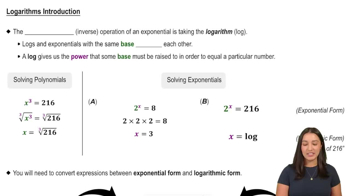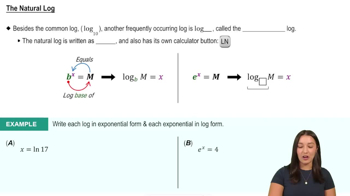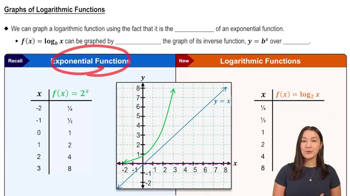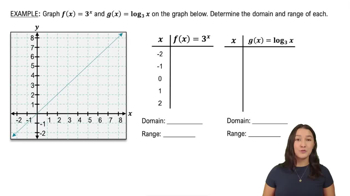Table of contents
- 0. Functions7h 52m
- Introduction to Functions16m
- Piecewise Functions10m
- Properties of Functions9m
- Common Functions1h 8m
- Transformations5m
- Combining Functions27m
- Exponent rules32m
- Exponential Functions28m
- Logarithmic Functions24m
- Properties of Logarithms34m
- Exponential & Logarithmic Equations35m
- Introduction to Trigonometric Functions38m
- Graphs of Trigonometric Functions44m
- Trigonometric Identities47m
- Inverse Trigonometric Functions48m
- 1. Limits and Continuity2h 2m
- 2. Intro to Derivatives1h 33m
- 3. Techniques of Differentiation3h 18m
- 4. Applications of Derivatives2h 38m
- 5. Graphical Applications of Derivatives6h 2m
- 6. Derivatives of Inverse, Exponential, & Logarithmic Functions2h 37m
- 7. Antiderivatives & Indefinite Integrals1h 26m
- 8. Definite Integrals3h 25m
0. Functions
Logarithmic Functions
Problem 4.2.52b
Textbook Question
{Use of Tech} Let f(x) = ln((x+1)/(x-1)) and g(x) = ln ((x+1)/(x-1)).
b. Sketch graphs of f and g to show that these functions do not differ by a constant.
 Verified step by step guidance
Verified step by step guidance1
Identify the functions f(x) and g(x) as both being equal to ln((x+1)/(x-1)).
Determine the domain of the functions by finding the values of x for which the argument of the logarithm is positive, which requires x > 1 or x < -1.
Calculate the derivatives f'(x) and g'(x) to analyze the behavior of the functions and confirm they are not constant by showing that the derivatives are not equal.
Choose specific values of x within the domain to evaluate f(x) and g(x) to illustrate their values at those points.
Plot the points and the general shape of the graphs of f(x) and g(x) on the same coordinate system to visually demonstrate that they do not differ by a constant.
Recommended similar problem, with video answer:
 Verified Solution
Verified SolutionThis video solution was recommended by our tutors as helpful for the problem above
Video duration:
1mPlay a video:
Was this helpful?

 7:3m
7:3mWatch next
Master Logarithms Introduction with a bite sized video explanation from Callie
Start learning




